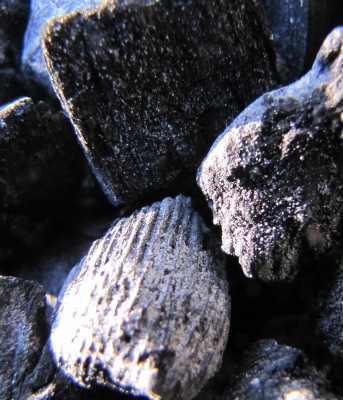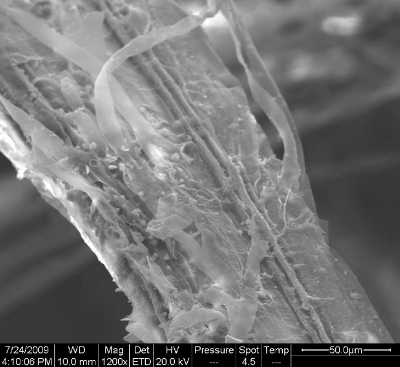
Biochar chemistry and biology
 I've posted previously about
the benefits
of biochar, but how
does biochar actually cause those increases in crop yield? It's
probably easiest for the average gardener to understand that the
increase in pH is caused by the ash that inevitably comes along for the
ride --- using wood
ashes to increase the alkalinity of (or "sweeten") soil is common
wisdom among farmers. And we can visualize the water retention
properties too since a closeup look at biochar makes it look like a
tiny sponge.
I've posted previously about
the benefits
of biochar, but how
does biochar actually cause those increases in crop yield? It's
probably easiest for the average gardener to understand that the
increase in pH is caused by the ash that inevitably comes along for the
ride --- using wood
ashes to increase the alkalinity of (or "sweeten") soil is common
wisdom among farmers. And we can visualize the water retention
properties too since a closeup look at biochar makes it look like a
tiny sponge.
The complexities come in
when you start thinking of the chemistry involved. Since biochar
is negatively charged, it naturally attracts anything positively
charged in the soil, and that includes important plant nutrients like
calcium, nitrates, phosphorus, and silicates. This chemical
attraction is why biochar in your soil prevents nutrient leaching --- the minerals are kept in
the root zone rather than washing into the subsoil during heavy rains.
All of these factors
help your plants grow, but probably the greatest benefit of biochar is
its ability to increase the populations of beneficial microorganisms in
the soil. In fact, one study of Amazonian Dark Earth (aka terra
preta) compared to nearby, natural soil showed that the Dark Earth
contained a completely different set of microorganisms than the natural
soil.
 Biochar helps many bacteria
and fungi grow because it provides tiny nooks and crannies just big
enough for these microorganisms but not large enough for predator
microorganisms. In their protected dens, the bacteria and fungi
grow like crazy, especially if you make your biochar at a relatively
low temperature so that the insides are coated with energy-rich tars
for them to eat. Scientists have found that arbuscular
mycorrhizae (the fungi that attach to your plants' roots and help them
get hard-to-find nutrients) are especially aided by biochar in the soil.
Biochar helps many bacteria
and fungi grow because it provides tiny nooks and crannies just big
enough for these microorganisms but not large enough for predator
microorganisms. In their protected dens, the bacteria and fungi
grow like crazy, especially if you make your biochar at a relatively
low temperature so that the insides are coated with energy-rich tars
for them to eat. Scientists have found that arbuscular
mycorrhizae (the fungi that attach to your plants' roots and help them
get hard-to-find nutrients) are especially aided by biochar in the soil.
Nitrogen-fixing
bacteria also love
biochar, but for a different reason. The biochar pores tend to
create low oxygen conditions where these anaerobic bacteria
thrive. As a result, legumes create more nitrogen-fixing nodules
when biochar is in the soil and free-living nitrogen-fixing bacteria
also multiply. That means more nitrogen for your plants without
any work on your part.
| This post is part of our Biochar in the Backyard lunchtime series.
Read all of the entries: |
Want more in-depth information? Browse through our books.
Or explore more posts by date or by subject.
About us: Anna Hess and Mark Hamilton spent over a decade living self-sufficiently in the mountains of Virginia before moving north to start over from scratch in the foothills of Ohio. They've experimented with permaculture, no-till gardening, trailersteading, home-based microbusinesses and much more, writing about their adventures in both blogs and books.
Want to be notified when new comments are posted on this page? Click on the RSS button after you add a comment to subscribe to the comment feed, or simply check the box beside "email replies to me" while writing your comment.

If you're going to make biochar, go for a retort kiln instead of a charcoal mound. You'll need less fuel and create much less pollution.
So, is biochar, wood ash and urine the the holy trinity of gardening?
Right now, I'm content to just use the charcoal I screen out of the wood stove. If my trials this summer turn out well and I want to expand, we'll definitely try to build something rather than just making charcoal in the ground. But I figure it's smart to start small so that I can tweak things.
I'm not sure I'd consider biochar, wood ash, and urine the holy trinity of gardening. Maybe compost, manure, and cover crops?
Good Day,
I have been looking for information on biochar just about everywhere. Do you know chemically why the biochar is negatively charged? Is it much like humus in that it has hydroxyl groups?
Does adding organic acids (humus) to biochar increase it's CEC ? Change it's structure (ie breaking double bonds and adding hydroxyl groups?)
Also, isn't the lye (ie KOH) extremely water soluble? You should be able to remove the lye and thus remove the alkalinity. This would also mean that the acid controlling properties of biochar are temporary as the KOH leaches through the soil profile.
Any technical documents you find or good references i would absolutely love. I understand chemistry very well and i want to understand how biochar works on the same level so i can explain this to people.
Cheers!!!
Sounds Good.
I have some new recent published papers that might shed some light into it. They are a couple 100 page documents so it might be over the weekend :P Also I might contact my UW professors too - it's a good question: Seems everybody is stumped, which is nuts cause the molecular composition of a material tells you pretty much everything you need to know about it
While the KOH in the ash is rather water soluble, the ASH also contains copious amounts of Calcium Carbonate (CaCO3). CaCO3 <-> Ca + CO3(2-). CO3(2-) + H+ <->> HCO3(1-). HCO3(1-) is super soluble in water, but calcium carbonate is not, so the overall reaction is slow. HCO3(1-) + H+ can also result into H2Co2, which can then break up into Water and CO2. The overall point here is that the ASH in terms of Calcium Carbonate can result in the removal of acids (H) permanently albeit slowly. Also, because calcium carbonate is not very soluble in water, i don't think there is a way to eliminate it if you already have alkalinic soils. The question here is how much CaCO3 is in the actual biochar vs just the ash. I think if you simply just separate the biochar from the ash, you remove most of the Calcium Carbonate. Then you can run water through the biochar to remove the KOH .
It's part of the puzzle anyway. NOTE: The previous is party based on informed speculation and is not 100% factual. Still working on the 100%
The reason Biochar is negative : It's functional groups.
Biochar may contain numerous functional groups, such as hydroxyl (OH), keton (O-R), ester (C=O), aldehyde (C-O), amino (NH2), nitro (NO2), and carboxyl [(C=O)OH].
-O and -OH bonds are very "magnetic" to positive charged nutrients (K+, NH4+, CA+, Mg+2). This is what Cation Exchange Capacity is all about.
I have to dig in a little more - but it seems that it also has really good Anion Exchange Capacity - equally as nice to have.
Essentially, as you said, it has a ton of similarities to humus. Only slightly burned so the carbon structure does't decay.
But...
Freshly produced biochar is hydrophobic and contains few polar, function groups at the surface, but after exposure to water and oxygen in the soil the biochar surfaces oxidizes and forms more carboxylic [(C=O)OH] and phenolic group(O-R). (Gheng, et al, 2008b)
My thought is that even better than putting it on air, compost speeds up the oxydation of biochar. THAT is it's true potential - after it's been fully oxidized. What's worse, if you put it in your soil without composting it, it can actually lead to nitrogen immobilization from the bacteria that are eating the remaining oils in the biochar. This goes away after a couple months or if you add nitrogen to compensate. My case is for composting - allow the material to fully oxidize and then load it up with nutrients from the compost. Perfect.
The reason Biochar is negative : It's functional groups.
Biochar may contain numerous functional groups, such as hydroxyl (OH), keton (O-R), ester (C=O), aldehyde (C-O), amino (NH2), nitro (NO2), and carboxyl [(C=O)OH].
-O and -OH bonds are very "magnetic" to positive charged nutrients (K+, NH4+, CA+, Mg+2). This is what Cation Exchange Capacity is all about.
I have to dig in a little more - but it seems that it also has really good Anion Exchange Capacity - equally as nice to have.
Essentially, as you said, it has a ton of similarities to humus. Only slightly burned so the carbon structure does't decay.
But...
Freshly produced biochar is hydrophobic and contains few polar, function groups at the surface, but after exposure to water and oxygen in the soil the biochar surfaces oxidizes and forms more carboxylic [(C=O)OH] and phenolic group(O-R). (Gheng, et al, 2008b)
My thought is that even better than putting it on air, compost speeds up the oxydation of biochar. THAT is it's true potential - after it's been fully oxidized. What's worse, if you put it in your soil without composting it, it can actually lead to nitrogen immobilization from the bacteria that are eating the remaining oils in the biochar. This goes away after a couple months or if you add nitrogen to compensate. My case is for composting - allow the material to fully oxidize and then load it up with nutrients from the compost. Perfect.